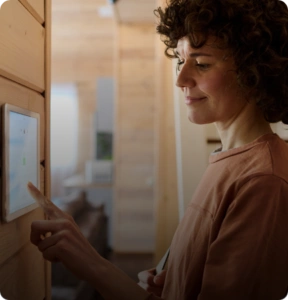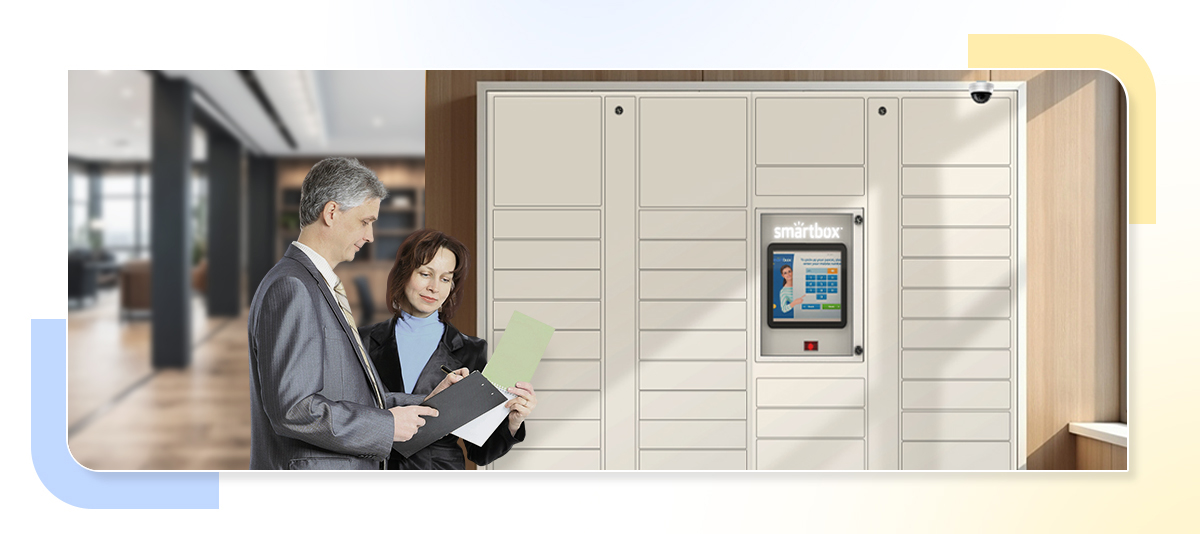Smart lockers are quickly becoming a staple in offices, schools, hospitals, and apartment complexes across the U.S. They streamline asset management and make package delivery secure, efficient, and contactless. But with rapid adoption comes an equally urgent responsibility: compliance.
Every installation must align with strict rules around ADA compliance for lockers, fire code regulations for smart lockers, locker accessibility standards, and smart locker building codes. Overlooking these requirements can expose property owners and facility managers to hefty fines, lawsuits, and even forced removal of non-compliant systems. Beyond financial penalties, the real cost is reputational damage and lost tenant or customer trust.
This guide breaks down the essentials – from ADA locker signage requirements and locker height requirements (ADA) to UL certification for lockers, NFPA fire safety codes, and commercial property locker codes. Whether you’re a property manager, real estate developer, or IT director, you’ll learn how to keep your intelligent locker system compliant while safeguarding your organization from risk.
Why Smart Lockers Compliance Matters
Installing smart lockers is more than a convenience upgrade – it’s a compliance responsibility. Ignoring key requirements like ADA compliance for lockers, fire code regulations for smart lockers, or electronic locker compliance USA can expose organizations to serious risks:
- Costly fines and penalties
Regulatory bodies at the federal, state, and local levels impose significant fines for violations of smart locker building codes, NFPA fire safety codes, and commercial locker regulations. - Lawsuits and legal action
Non-compliant systems may trigger lawsuits from tenants, employees, or customers—particularly in cases involving locker accessibility standards, privacy violations, or security breaches. - Reputational damage
A failed installation or publicized non-compliance issue can erode trust with tenants, residents, or business partners – damaging long-term growth.
Beyond universal standards like the Americans with Disabilities Act lockers (ADA) and local building code locker rules, organizations must also navigate state-level laws such as the California Consumer Privacy Act (CCPA). Industry-specific requirements add another layer:
- Healthcare → HIPAA-compliant secure locker installations
- Finance → Data security and locker security guidelines
- Education → Student privacy and public access locker compliance
In short, compliance isn’t optional – it’s the foundation for a secure, accessible, and legally sound smart locker deployment.
Essential Regulatory Standards for Smart Lockers
Smart locker deployments touch multiple areas of compliance – from data privacy to industry-specific mandates. To keep your intelligent locker system compliant, organizations must navigate a mix of federal, state, and industry regulations, along with global standards often adopted in the U.S.
Federal and State Data Privacy Laws
- California Consumer Privacy Act (CCPA)
Any smart locker system deployed in California that collects or processes personal data must meet CCPA compliance. This includes transparent data handling policies, opt-out rights, and robust locker security guidelines to safeguard sensitive information.
- Federal Trade Commission (FTC) Guidelines
The FTC enforces strict electronic locker compliance with USA requirements for data protection across all states. Locker providers must ensure secure identity authentication, encrypted protocols, and protection against cyber threats.
- Emerging Federal Policies
New regulations continue to evolve around cybersecurity, privacy, and smart locker safety standards. Federal agencies are introducing rules that raise the bar for how electronic and secure locker installations handle sensitive user data.
Industry-Specific Regulations
- Healthcare (HIPAA)
Smart lockers used for medical records, pharmaceuticals, or patient assets must comply with HIPAA requirements—ensuring secure locker installations with restricted access, audit trails, and data protection.
- Financial Sector (PCI-DSS)
In environments where transactions occur (e.g., payment-enabled pickup), PCI-DSS compliance requires encrypted transactions, secure networks, and restricted access controls to prevent breaches.
- Education (FERPA)
Schools and universities using lockers for student records or assets must follow FERPA regulations, which mandate privacy and limit unauthorized access to student data.
Global Standards Often Adopted in the U.S.
- ISO/IEC 27001
While not mandated by U.S. law, many organizations adopt ISO 27001 as a benchmark for locker security guidelines and information security management. Aligning with this framework strengthens compliance efforts and enhances trust with global stakeholders.
Smart Locker Compliance Essentials & Best Practices
Achieving compliance isn’t just about checking boxes – it’s about building a secure, resilient, and regulation-ready locker system. Below are best practices every organization should adopt to meet ADA compliance for lockers, fire code regulations for smart lockers, locker security guidelines, and broader electronic locker compliance USA requirements.
1. Controlled Access & User Authentication
- Implement multi-factor authentication (PIN codes, RFID badges, biometrics, or mobile apps).
- Restrict locker access to authorized users only, minimizing both insider misuse and external threats.
- For ADA locker accessibility standards, ensure authentication systems also support touchless locker access and alternate modes for differently abled users.
2. Automated Audit Trails & Real-Time Reporting
- Record every transaction – pickups, returns, and drop-offs – with time-stamped audit logs.
- Enable real-time compliance reporting so facility managers can monitor adherence to commercial locker regulations and investigate incidents quickly.
- Maintain digital records for regulatory audits or building inspections.
3. Data Security Protocols
- Use AES-256 encryption for all locker data transmissions to align with smart locker safety standards.
- Apply automated software updates and frequent vulnerability patching to defend against cyber threats.
- Align with ISO 27001 information security benchmarks, often adopted in U.S. compliance frameworks.
4. Physical Security Measures
- Install tamper-resistant hardware and surveillance cameras around locker systems.
- Use reinforced build materials for secure locker installations, reducing theft or vandalism risks.
- Follow NFPA fire safety codes when integrating lockers into shared corridors or public spaces.
5. Supply Chain Security
- Vet suppliers thoroughly to ensure components meet cybersecurity and smart locker deployment regulations.
- Conduct routine supply chain audits for software, hardware, and integrations.
- Maintain end-to-end visibility from procurement through deployment to avoid introducing vulnerabilities.
6. Incident Response Planning
- Draft clear policies for reporting and responding to security breaches.
- Train staff regularly in compliance procedures, locker security guidelines, and emergency protocols.
- Ensure escalation paths are in place for both physical and digital incidents.
7. Asset Surveillance & Management
- Tag high-value assets with RFID or IoT sensors for real-time asset tracking.
- Use centralized locker management systems with customizable compliance reports.
- Support facility managers during regulatory inspections by generating instant documentation.
Common Compliance Pitfalls – and How to Avoid Them
Even well-intentioned smart locker deployments can fail compliance checks if key details are overlooked. Below are the most common pitfalls – and the steps you can take to avoid them.
1. Weak Passwords & Authentication
- The risk: Simple or reused passwords make systems vulnerable to unauthorized access.
- The fix: Enforce strong authentication policies with complex passwords, frequent updates, and multi-factor authentication (MFA) such as biometrics or mobile apps. This supports both electronic locker compliance USA and modern locker security guidelines.
2. Outdated Software & Firmware
- The risk: Old versions introduce exploitable vulnerabilities that compromise smart locker safety standards.
- The fix: Implement a regular patch management cycle, ensuring all software and firmware updates are tested and applied promptly. Automated updates where possible to maintain intelligent locker system compliance.
3. Insufficient User Training
- The risk: Staff errors often cause compliance failures, from incorrect locker assignments to mishandled user data.
- The fix: Provide ongoing compliance training for all administrators, property staff, and operators. Include ADA requirements, touchless locker access protocols, and incident response procedures in the curriculum.
4. Poor Access Controls
- The risk: Over-permissioned staff accounts create insider threats and regulatory violations.
- The fix: Limit access to locker management interfaces to essential personnel only. Use role-based access controls (RBAC) and conduct quarterly reviews of user permissions to stay aligned with commercial property locker codes and security audits.
5. Ignoring Supply Chain Risks
- The risk: Imported or uncertified hardware can violate UL certification for lockers, NFPA fire safety codes, or introduce hidden cybersecurity risks.
- The fix: Audit all suppliers, components, and integrations regularly. Require documentation that demonstrates compliance with smart locker deployment regulations and maintain a chain-of-custody log for procurement.
How Smartbox Supports Compliance & Risk Mitigation
When deploying smart lockers, aligning with locker accessibility standards, fire and building codes, electronic locker compliance USA, and locker security guidelines is critical. Smartbox’s turnkey solutions help simplify that journey:
Enterprise-Grade Security & Surveillance
Smartbox lockers feature tamper-proof compartments and come equipped with 24/7 surveillance cameras, ensuring physical protection and compliance with smart locker safety standards.
Modular, Scalable Hardware
Their modular compartments and customizable configurations – suitable for indoor, outdoor, refrigerated, or all-weather deployments – make it easy to align with local building code locker rules, ADA locker signage requirements, and smart locker building codes.
Intuitive Software with Real-Time Tracking
Smartbox’s cloud-based software provides live monitoring, audit-ready reporting, and seamless workflows – strongly aligning with automated audit trails, real-time reporting, and electronic locker compliance USA.
Trusted Across Industries
Smartbox offers tailored solutions – Smart Collect for residential package pickup, Smart Serve for IT asset management, and Smart Last-Mile for retail and logistics. Each is designed with compliance in mind, making them ideal for regulated sectors like healthcare, multifamily dwellings, universities, and corporate offices.
Integrated Compliance-by-Design
- Access Controls & Authentication: Systems support secure access via unique codes and can integrate with MFA setups – helping maintain controlled access & user authentication.
- Audit Logs and Incident Tracking: Real-time logs make it easier to adhere to regulatory audits and maintain a full chain of custody for every transaction.
- Flexibility for Compliance Testing: Their scalable design allows for integration with local AHJ requirements and easy adaptation to NFPA fire safety codes and ADA reach standards.
Why Smartbox Matters for Compliance
| Compliance Challenge | How Smartbox Helps |
| Physical security & tamper-resistance | Tamper-proof lockers + constant surveillance ensure integrity |
| Site-specific deployment complexity | Modular hardware fits ADA and building-code constraints |
| Audit and traceability requirements | Centralized, real-time reporting supports inspection readiness |
| Varying use cases across industries | Multiple solutions tailored for healthcare, residential, logistics, and more |
How Compliance Protects Your Organization
Compliance isn’t just about checking boxes or avoiding fines – it’s a strategic advantage. A compliant smart locker system does more than protect you from lawsuits; it:
- Builds customer trust by guaranteeing secure locker installations that meet ADA locker accessibility standards and NFPA fire safety codes.
- Demonstrates proactive risk management to investors, regulators, and partners – showing that your business takes electronic locker compliance USA seriously.
- Strengthens operational reliability by reducing downtime, avoiding failed inspections, and ensuring lockers remain aligned with commercial property locker codes and local building code locker rules.
Forward-thinking organizations treat compliance as an ongoing process. They monitor new legislation, invest in compliance-driven smart locker technology, and maintain transparency in every transaction – from touchless locker access to audit trail reporting.
In short, compliance transforms smart lockers from a convenience feature into a secure, future-proof infrastructure investment that protects your organization’s reputation, customers, and bottom line.
Frequently Asked Questions (FAQ)
What compliance standards apply to smart locker installations in the U.S.?
What are the ADA requirements for smart lockers?
Why is UL certification important for electronic lockers?
How can property managers ensure ongoing compliance after installation?
What are the biggest risks of non-compliance with smart locker regulations?
























